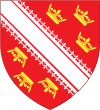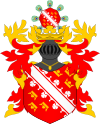Argentoratum
 Geographic and strategic location of Argentoratum | |
| Location | France |
|---|---|
| Region | Grand Est |
| Coordinates | 48°34′58″N7°45′04″E/ 48.5827°N 7.751°E |
ArgentoratumorArgentoratewas theancientname of the city ofStrasbourg.The name was first mentioned in 12 BC, when it was a Roman military outpost established byNero Claudius Drusus.From 90 AD theLegio VIII Augustawas permanently stationed there.
History[edit]
TheRomansunderNero Claudius Drususestablished a military outpost belonging to theGermania SuperiorRoman provinceclose to aGaulishvillage near the banks of theRhine,at the current location ofStrasbourg,and named it Argentoratum. Its name was first mentioned in 12 BC but "Argentorate" is thetoponymof the Gaulish settlement that preceded it before beinglatinised,though it is not known by how long.[1]

From 90 AD theLegio VIII Augustapermanently stationed in Argentoratum.[2]The Roman camp of Argentoratum then included acavalrysection and covered an area of approximately 20hectares(49 acres), from approximately 6 hectares (15 acres) inTiberiantimes.[3]Other Roman legions temporarily stationed in Argentoratum were theLegio XIV Geminaand theLegio XXI Rapax,the latter during the reign ofNero.[4]
TheAlemannifought aBattle of Argentoratumagainst Rome in 357 AD. They were defeated byJulian,laterEmperor of Rome,and their kingChnodomarwas taken prisoner. On 2 January 366 the Alemanni crossed the frozenRhinein large numbers, to invade the Roman Empire.
From the 4th century, Strasbourg was the seat of theBishopric of Strasbourg(made an Archbishopric in 1988).
Early in the 5th century the Alemanni appear to have crossed the Rhine, conquered, and then settled what is today Alsace and a large part ofSwitzerland.From this period on Argentoratum disappears from historical records and is replaced by thetoponym"Stratisburgum".
The site[edit]
The centre of the camp of Argentoratum proper was situated on theGrande Île,with thecardobeing the current Rue du Dôme and thedecumanus,the currentRue des Hallebardes.[5]

As systematic archaeological studies between 1947 and 1953,[6]conducted byJean-Jacques Hatt,archaeologist and director of theMusée archéologique de Strasbourg,have shown, Argentoratum was destroyed by fire and rebuilt six times between the first and the 5th century AD: in 70, 97, 235, 355, in the last quarter of the 4th century, and in the early years of the 5th century. It was underTrajanand after the fire of 97 that Argentoratum received its most extended and fortified shape.[7]
Many Roman artifacts have also been found along the road that led to the camp, the currentRoute des Romainsin the suburb of Koenigshoffen,[8]such as the stele ofCaius Largennius.This was where the largest burial places (necropoli) were situated, as well as the densest concentration of civilian dwelling places (vici) and commerces next to the camp.[9]
Among the most outstanding finds in Koenigshoffen were the fragments of a grandMithraeumthat had been shattered byearly Christiansin the 4th century (found in 1911–12 byRobert Forrer,Hatt's predecessor at the head of the Musée archéologique).[10]
Archaeological digs by J.-J. Hatt below the currentSaint Stephen's Churchin 1948 and 1956 have unearthed theapseof a church dating back to the late 4th century or early 5th century, and considered the oldest church inAlsace.It is supposed that this was the first seat of theCatholic Diocese of Strasbourg.[11]
References[edit]
- ^Petit historique de Strasbourg(in French)
- ^Le camp de la Legio VIII Augusta à Strasbourg(in French)
- ^4 rue Brûlée(in French)
- ^Argentorate sous Néron(in French)
- ^Argentorate: description(in French)
- ^Favoured by the destructions the city had suffered duringWorld War II,especially from British and American bombings in August 1944.
- ^Résultats historiques et topographiques des dernières fouilles de Strasbourg, de 1949 à 1951(in French);Les fouilles de Strasbourg et de Seltz en 1952 et 1953(in French)
- ^Argentoratum.com: Les fouilles archéologiques(in French)
- ^Le vicus et les canabae(in French)
- ^The Roman Cult of Mithras: The God and His Mysteries
- ^Fouilles romaines sous l'église Saint-Étienne à Strasbourg(in French)
External links[edit]
- Argentoratum (Strasbourg)on Livius.org
- www.argentoratum.com(in French)
- Histoire de Strasbourg: quand Strasbourg était Argentorate(in French)
- Argentorate, Strasbourg,by Jean-Jacques Hatt(in French)



